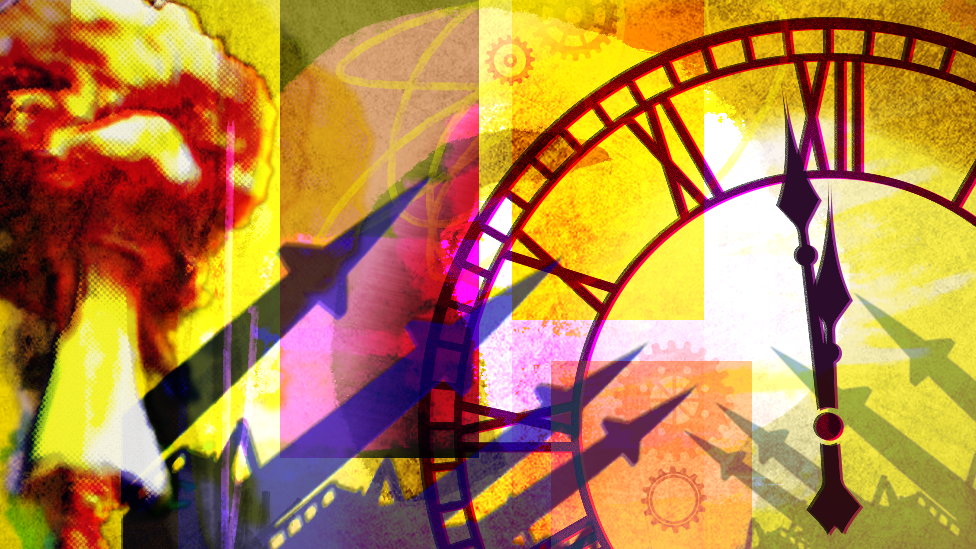ARTICLE AD BOX

The Doomsday Clock - which shows how symbolically close the world is to nuclear Armageddon - is to remain at 90 seconds to midnight.
Scientists have listed reasons for keeping its hands the closest they have ever been to "Doomsday" - but stopped short of nudging it further forward.
The threat of a new nuclear arms race, the Ukraine war and climate change concerns were all factors, they said.
The clock is set annually by the Bulletin of the Atomic Scientists.
Since 2007, members have considered the impact of new man-made risks such as AI and climate change, as well as the greatest threat - nuclear war.
In its 2024 announcement on Tuesday, the Bulletin said that China, Russia and the US were all spending huge sums to "expand or modernise their nuclear arsenals" - which added to the "ever-present danger of nuclear war through mistake or miscalculation".
The war in Ukraine had also created an "ever-present risk of nuclear escalation", it said.
A lack of action on climate change and risks linked to "misusing" emerging biological technologies and Artificial Intelligence (AI) tools were also cited.
The Doomsday Clock was created in 1947 by J Robert Oppenheimer and fellow US scientists who had developed the atomic bomb.
They had seen its devastating effects two years earlier, at the end of World War Two, on the Japanese cities of Hiroshima and Nagasaki. They wanted to warn the public and put pressure on world leaders to make sure nuclear weapons were never used again.
The hands of the clock have moved 25 times. In 1947, they started at seven minutes to midnight. At the end of the Cold War, in 1991, they had fallen back to 17 minutes to midnight.
Bulletin president Rachel Bronson told the BBC that "every major country, including the UK, is investing in their nuclear arsenal as if nuclear weapons are usable for a very long time. This is a very dangerous time… leaders are not acting responsibly."
With the Doomsday Clock the closest it's ever been to midnight, Jane Corbin investigates the proliferation of nuclear weapons across the globe and the breakdown of systems of constraint.
Pavel Podvig, a Russian nuclear weapons expert who has been involved in setting the Doomsday Clock for many years, says he was shocked when President Putin put Russia's nuclear forces on alert after the invasion of Ukraine.
The world reacted with horror to the Russian leader's threat but it seems he had made a deliberate calculation.
"This is exactly what nuclear weapons are there for - to make certain you have a certain freedom of action," Podvig says. "The Russian President believed that by making these statements he could deter the West from intervening in Ukraine which was a correct calculation - this is how deterrence works."
Despite decades of arms control agreements there are still about 13,000 nuclear warheads globally, 90% of them Russian and American. Six other countries are declared nuclear powers: the UK, France, China, India, Pakistan and North Korea. Israel is widely believed to have these weapons, but has never confirmed it. Most modern nuclear weapons are many times more powerful than those that destroyed Hiroshima and Nagasaki.
In 2021, the UK increased the cap on its warheads from 225 to 260, potentially 35 more warheads, and the country's nuclear force is on high alert. Since the war in Ukraine began, there has been rhetoric from senior Russian figures suggesting Moscow's nuclear weapons could be used against the UK.
The UK's nuclear deterrent is housed in the west of Scotland at the Faslane base, home to four Vanguard submarines that carry Trident missiles armed with nuclear warheads.
Image source, Getty Images
Image caption,HMS Vigilant, one of the UK's Vanguard submarines, stationed at Faslane
Feargal Dalton, a former Lt Cdr who served on board submarine HMS Victorious, is one of a handful of people who have actually fired a Trident missile: a test missile with a dummy warhead.
"There's always one [submarine] somewhere out there, at 15 minutes notice to fire," Dalton says. "As we speak there is a nuclear deterrent out there. The Vladimir Putins of the world know it's out there, it's credible and we could use it if needs be."
Ever since the atomic bomb was created there has been opposition to these weapons. In the 1980s, the women of the Greenham Common peace camp fought to get all US nuclear missiles removed from UK soil - the last warheads left in 2008.
CND protesters at RAF Lakenheath in Suffolk
However, at RAF Lakenheath in Suffolk the Campaign for Nuclear Disarmament (CND) is now protesting against the possibility of US weapons returning.
Pentagon documents - first reported by the Federation of American Scientists - suggest US "special" weapons will be stationed at the base. US fighter planes that are capable of dropping such weapons arrived at Lakenheath in 2021 and there are now plans by the United States Air Force to build dormitories for troops to serve in a potential nuclear mission on this site.
"We know that we have got public opinion on our side," Sophie Bolt from CND explains - as her small group chant slogans over the perimeter fence of the base. "Nearly 60% of the population do not want to have nuclear bombs sited in Britain."
Image source, Getty Images
Image caption,RAF Lakenheath is home to the US Air Force's 48th Fighter Wing
"We've got nothing to do with this base, it is totally under US control," Alan Wright, another protestor says. "If we get Trump in [the White House] next time and he may press the button because he's got a bigger button than Putin - then we are a target."
However, Donald Trump has previously said he would end the war in Ukraine within 24 hours of being elected, although he hasn't explained how. Some analysts believe it is likely that US support for Ukraine could be diminished.
In the past decade, fears of a nuclear war have also been ramped up by Kim Jong-Un, leader of North Korea, the latest nation to join the nuclear club. He has boasted of testing nuclear-capable missiles that could reach the United States.
Former Bulletin of Atomic Scientists member and Doomsday Clock adviser, Sig Hecker, has visited North Korea's nuclear facilities seven times as part of a scientific research programme and estimates it could have 50 to 60 nuclear warheads by now.
"Nuclear weapons, nuclear terrorism, nuclear proliferation - it's all going in the wrong direction," he says.

 1 year ago
23
1 year ago
23








 English (US) ·
English (US) ·